Bluetooth sits in a fun little space within the Ultra High Frequency (UHF) band of the radio frequency (RF) portion of the electromagnetic (EM) spectrum. I promise we didn’t make all that up to sound smart. You can read our last post on digital wayfinding in healthcare to get the scoop on radio waves if you missed it. In that post, we took you back to science class. This time, let’s have a little history class.
The Bluetooth Saga
Bluetooth was the nickname of King Harald Gormsson, and its logo was a binding rune of his initials. He fought great wars and united the Danes, in the very same way that Bluetooth technology unites devices using agreed upon protocols and a reserved signal space. These are equally epic things. It’s a classic story of a goofy, internal project name getting too popular to shake, despite an early effort to rebrand it as the less fun, "Radiowire."
From a frequency perspective, the Bluetooth band sits content between 2.402 GHz to 2.48 GHz, which makes it a next door neighbor to the sorts of super famous microwaves that you might recognize from kitchens. Being on the higher end of radio frequency, Bluetooth delivers a nice data transmission rate, but a limited range.
Bluetooth is a great fit for the very useful case of communication between devices, its most intended purpose. Cords are dumb, nobody likes them, and Bluetooth helps free us from those soft plastic shackles. The rapid data transmission of Bluetooth allows for responsive, lagless pairing for peripherals like a computer mouse or streaming audio to a pair of earbuds. Connecting two devices via Bluetooth is called ‘pairing’.
A cousin specification to Bluetooth, Bluetooth Low Energy (BLE) manages, through fancy tricks and witchcraft, to provide a similar experience while greatly reducing the energy cost. The name really gives that one away. This lets enterprising device creators build a slim-profiled, BLE enabled device with enough power to last for years. This profile is ideal for ‘always on’ devices like wearables or beacons.
BLE is very well proliferated. Effectively, every mobile device built in the past 10 years supports it. The ones that don’t would be very intentional, like a hipstery flip phone or locked down secure device.
Importantly, even if we’re not interested in pairing (which we’re not, really, for wayfinding purposes), mobile devices are able to detect and discover Bluetooth signals as part of the pairing process. Said differently for extra emphasis, pretty much every mobile device is designed out of the box to be really good at detecting, parsing, and processing Bluetooth signals. These data packets can contain powerful pieces of information, which sets us up for the next section of the article.
Beacons of Hope
One very useful piece of technology of particular relevance to wayfinding is a beacon. Beacons are simply small devices that broadcast a signal. While there are other types of beacons, what we’re interested in is a BLE signal for a BLE beacon because:
- They are cheap and easy to source
- They are widely supported by consumer devices
- Properly optimized, battery operated beacons can last for years
- Installation is easy, with no hardwired connections needed
- No long term maintenance or recalibration is necessary
- They are a nice size, similar to an old school pager
Included in this transmission is a data packet which follows certain protocols according to the Bluetooth standard. Some useful bits of information in the data packet include the signal strength of the transmission and identifying information about the beacon itself.
Reflecting back to our previous conversations on wayfinding techniques, you’ve no doubt realized that this gives us what we need for either proximity based wayfinding or trilateration. Unfortunately, none of the pros of BLE outweigh the cons of those methods. While most obstructions won’t completely block a Bluetooth signal, it does degrade it, which compromises distance estimations. This can still be an ok solution if accuracy isn’t very important, or if obstructions aren’t a problem, like in a high-ceiling, large room retail environment.
There’s a similar issue with pure proximity based location determination, but BLE beacon’s low cost does make this an option to augment the deficiencies of other indoor location determining methods. A geomagnetic fingerprinting solution, for instance, can be combined with proximity BLE beacons to help it out with the floor level accuracy where it would otherwise struggle.
Speaking of fingerprinting, this is where BLE truly shines. The easy install of BLE beacons lends itself well to creating that rich tapestry of radio you need to make each individual location a special little signal snowflake. Combine this with its nigh universal compatibility and modern phone’s adept capabilities at processing Bluetooth in particular, and you have yourself a compelling solution.
With the tight control on the Bluetooth band, interference with non-Bluetooth equipment is a non-issue. This makes BLE based solutions ideal for indoor positioning in healthcare and industrial settings where there’s a lot of important equipment to not interfere with. Even with BLE devices, given the nature of most Bluetooth usage, interference could only really be an issue in a very extreme circumstance. Even then there are techniques for redundancy which make it a non-issue.


